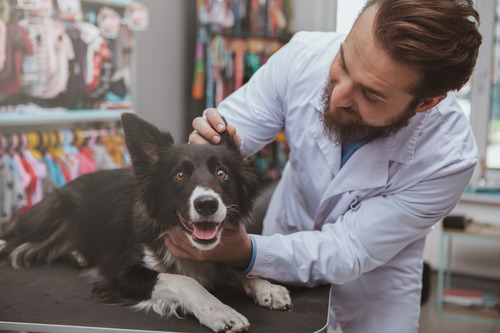When something seems “off” with your pet, it’s not always easy to tell whether it’s a true emergency or something that can wait until the next day. But certain symptoms and situations require immediate attention. As a pet owner, recognizing the warning signs and knowing when to call the emergency vet can make a life-saving difference. At Creekside Pet Care Center in Keller, TX, our team is here 24/7 to offer emergency vet care in those stressful moments. This blog will walk you through six common signs that indicate your pet needs emergency veterinary care right away—so you can feel more confident taking quick action when it matters most.
1. Difficulty Breathing
Breathing problems can escalate quickly and should never be ignored. If your pet is panting heavily without recent exertion, gasping for air, or showing signs of labored or open-mouth breathing, contact an emergency vet right away. These symptoms can indicate issues such as heart failure, asthma, allergic reactions, or airway blockages.
What to Watch For
Signs that your pet is struggling to breathe include flared nostrils, extended neck posture, blue or pale gums, and wheezing. Cats and dogs may also seem restless or panicked due to lack of oxygen. If you observe any of these symptoms, bring your pet to Creekside Pet Care Center immediately.
Causes of Breathing Problems
Common causes include trauma to the chest, foreign objects lodged in the throat, heatstroke, or respiratory infections. In some cases, heart or lung disease could be the underlying issue, requiring urgent diagnostics and intervention by an emergency vet.
2. Uncontrolled Bleeding
Bleeding that doesn’t stop within a few minutes—whether external or suspected internal—is always an emergency. This can result from a severe injury, trauma, or even a ruptured growth.
Types of Bleeding to Look Out For
External bleeding from wounds, the nose, or mouth should be addressed right away. Internal bleeding may not be visible, but signs like a bloated abdomen, pale gums, or weakness could point to internal trauma. Only an emergency vet can accurately diagnose and manage this kind of situation.
Why Immediate Care Is Critical
Uncontrolled bleeding can lead to shock, organ damage, or death. Prompt stabilization and treatment can dramatically improve your pet’s outcome, especially if blood transfusions or surgery are necessary.
3. Persistent Vomiting or Diarrhea
A single episode of vomiting or diarrhea isn’t usually a reason to panic. But when it continues for hours, is paired with lethargy, or contains blood, it’s time to seek help.
Dehydration Risk
Pets can become dangerously dehydrated very quickly when they experience persistent vomiting or diarrhea. Dehydration affects organ function and overall stability. If your pet can’t keep water down or is showing signs of weakness, contact our emergency vet team in Keller, TX.
Underlying Conditions
Severe gastrointestinal symptoms may indicate poisoning, pancreatitis, intestinal blockages, or infectious diseases. These issues require rapid diagnostics and medical support that only an emergency vet can provide.
4. Sudden Collapse or Inability to Stand
If your pet suddenly collapses, can’t get up, or is disoriented and weak, this could be a sign of something life-threatening. Sudden changes in mobility are never normal and should be addressed without delay.
Possible Causes
Collapse may result from internal bleeding, neurological conditions, toxin ingestion, or heatstroke. It can also be a sign of severe pain, low blood sugar, or cardiac issues. Regardless of the cause, your pet needs immediate evaluation by your emergency vet at Creekside Pet Care Center.
Signs to Act On
In addition to collapse, look for symptoms such as shaking, confusion, vomiting, or difficulty breathing. Any of these may signal a medical emergency that requires urgent veterinary care.
5. Seizures or Severe Disorientation
Witnessing your pet have a seizure can be frightening. A single seizure may not always require emergency treatment, but a seizure lasting more than a couple of minutes or clusters of seizures are cause for immediate concern.
Signs of Seizure Activity
Seizures often include muscle spasms, drooling, paddling, loss of consciousness, or uncontrolled urination and defecation. Some pets may seem confused or anxious before and after a seizure.
When to Call the Emergency Vet
If your pet has more than one seizure in 24 hours or experiences a seizure that doesn’t stop after a few minutes, call (817) 421-5850 or bring them straight to Creekside Pet Care Center. Seizures can result from toxins, metabolic imbalances, or neurological disorders, all of which require urgent care.
6. Trauma or Suspected Injury
Injuries from accidents, such as being hit by a car or attacked by another animal, can lead to serious internal damage—even if your pet seems “okay” on the outside.
Signs That May Not Be Obvious
Pets are good at hiding pain. Limping, swollen limbs, vocalizing, or a change in behavior can all indicate an injury. Internal injuries or organ damage can develop without visible signs and worsen without treatment.
Don’t Wait to Seek Help
If your pet has been in a traumatic incident, always err on the side of caution. Call or visit our emergency vet clinic in Keller right away so we can assess their condition and begin treatment if needed.
Prompt Action Can Make All the Difference
When your pet shows signs of distress, your instincts as a pet owner matter. But you don’t have to make these decisions alone. The emergency vet team at Creekside Pet Care Center in Keller is ready to help 24 hours a day, 7 days a week. Whether your pet is struggling to breathe, has been injured, or is showing sudden behavioral changes, our team can provide the immediate medical attention they need. If you’re unsure whether your pet needs emergency care, it’s always better to make the call. Reach us anytime at (817) 421-5850.






